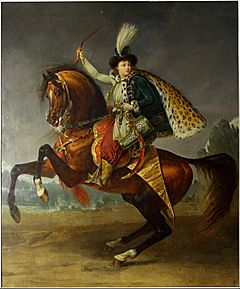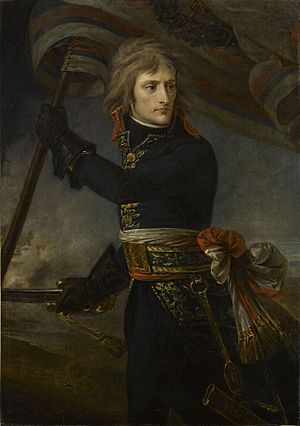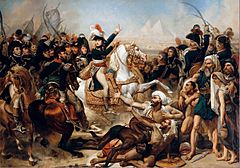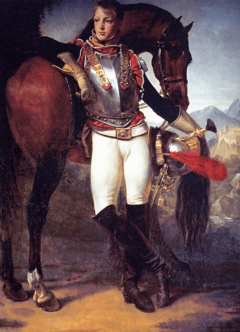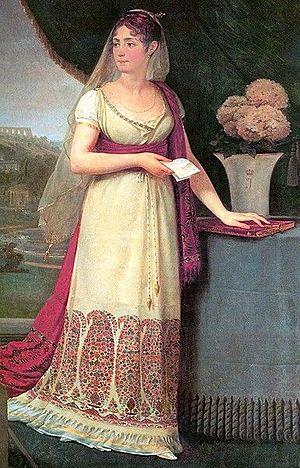Antoine-Jean Gros facts for kids
Quick facts for kids
Antoine-Jean Gros
|
|
|---|---|
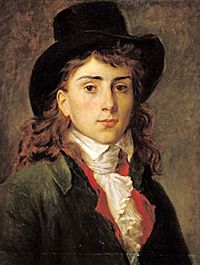
Antoine-Jean Gros at age 20, c. 1791
|
|
| Born | 16 March 1771 |
| Died | June 25, 1835 (aged 64) near Meudon, France
|
| Resting place | Père Lachaise Cemetery |
| Nationality | French |
| Education | Collège Mazarin |
| Known for | Painting |
Antoine-Jean Gros (born March 16, 1771 – died June 25, 1835) was a famous French painter. He was known for painting important historical events and people. In 1824, he was given the special title of Baron Gros.
Gros learned painting from Jacques-Louis David in Paris. He started his own art career during the French Revolution. Because of the Revolution, Gros had to leave France and moved to Genoa, Italy. His painting of the French leader Napoleon Bonaparte at the Battle of Arcole (1796) made him very famous. This painting also helped him become a favorite artist of Napoleon.
Gros traveled with Napoleon's army for several years. He returned to Paris in 1799. He painted many large pictures of battles and other events from Napoleon's life. Gros was also a very good portrait painter, capturing people's likenesses.
Contents
Early Life and Art Training
Antoine-Jean Gros was born in Paris, France. He began learning to draw at just six years old. His father, Jean-Antoine Gros, was a painter of small portraits. Antoine-Jean showed great talent from a young age. His mother, Pierrette-Madeleine-Cécile Durand, was also an artist.
In 1785, Gros chose to join the art studio of Jacques-Louis David. He worked hard there and also continued his studies at the Collège Mazarin. In 1791, his father passed away, and his family faced financial difficulties due to the French Revolution. Gros then focused completely on his painting career. He tried to win a big art prize in 1792 but didn't succeed. Around this time, he painted portraits of important members of the French government. However, as the Revolution became more intense, Gros left France in 1793 and went to Italy.
Life in Genoa and Meeting Napoleon
In Genoa, Italy, Gros earned money by painting portraits. He also visited Florence. When he returned to Genoa, he met Joséphine de Beauharnais, who was Napoleon's wife. Gros followed her to Milan, where he was welcomed by her husband, Napoleon Bonaparte.
After Gros painted the famous scene Bonaparte at the pont d'Arcole, Napoleon gave him a special job. This job allowed Gros to travel with the army. In 1797, Gros was given the task of choosing valuable art and treasures to be sent to the Louvre museum.
Return to Paris
In 1799, Gros left Genoa and traveled back to Paris. By early 1801, he had set up his art studio. He created a study for a painting called Battle of Nazareth, which won a prize in 1802. However, the full painting was never finished.
Gros was then asked to paint Bonaparte Visiting the Plague Victims of Jaffa. This important painting is now in the Louvre museum. After that, in 1806, he painted Battle of Abukir, 25 July 1799, which is now at Versailles. In 1808, he completed Napoleon on the Battlefield of Eylau, also now in the Louvre.
The Salon of 1804
At the Salon of 1804, a major art exhibition, Gros showed his painting Bonaparte Visiting the Plague Victims of Jaffa for the first time. This painting truly launched his successful career. It shows Bonaparte in Jaffa visiting soldiers who were sick with a serious illness. He is shown reaching out to one of the sick soldiers, appearing brave and unafraid of the disease.
Napoleon asked Gros to paint this scene to counter negative stories about him. The painting showed a caring Napoleon visiting the sick in the hospital. This helped to create a positive image of the leader.
Later Life and Passing
By 1810, Gros's paintings like Madrid and Napoleon at the Pyramids (now at Versailles) showed that Napoleon's support for him had lessened. However, his painting of Francis I and Charles V in 1812 (now in the Louvre) was very successful.
His Fame and Influence
Napoleon made Gros a member of the Legion of Honour in 1808. This was after Gros displayed his Battle of Eylau painting. Gros had many students who learned from him. His influence grew even more when his teacher, David, left Paris in 1815.
During the time of the Bourbon Restoration, Gros became a member of the Académie des Beaux-Arts. He also became a professor at the École des Beaux-Arts. In 1824, King Charles X of France gave him the special title of baron.
Gros also inspired another famous painter, Eugène Delacroix, especially with his printmaking work. Both artists lived and worked around the same time and painted Napoleon. However, at one point, Gros criticized Delacroix's painting Chios and Missolonghi, calling it "a massacre of art."
Several books have been written about Antoine-Jean Gros and his art.
Iconography
| Image | Title | Date | Dimensions | Collection |
|---|---|---|---|---|
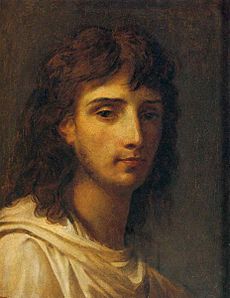 |
Autoportrait | 1795 | Palace of Versailles | |
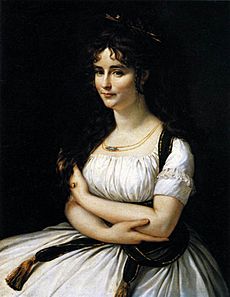 |
Madame Pasteur | 1795–1796 | The Louvre | |
| Portrait of Madame Bruyere | 1796 | 79 × 65 cm | Bristol City Museum and Art Gallery | |
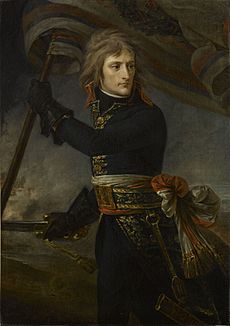 |
Bonaparte at the Pont d'Arcole | 1796 | 130 × 94 cm | Palace of Versailles |
| The Death of Timophanes | 1798 | 44.4 × 57.6 cm | The Louvre | |
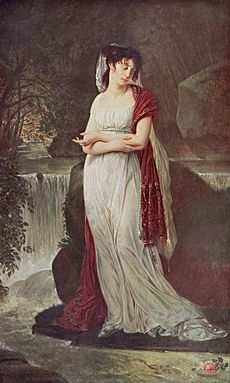 |
Portrait of Christine Boyer | c. 1800 | 214 × 134 cm | The Louvre |
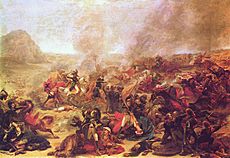 |
The Battle of Nazareth | 1801 | 136.1 x 196.4 cm | Musée des Beaux-Arts de Nantes |
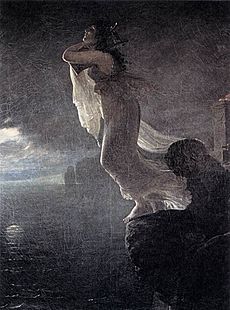 |
Sappho at Leucate | 1801 | 122 × 100 cm | Musée Baron Gérard, Bayeux |
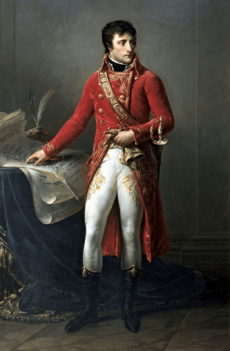 |
First Consul Bonaparte | 1802 | 205 × 127 cm | Musée de la Légion d'honneur |
| Bonaparte Visiting the Plague Victims of Jaffa | 1804 | 715 × 523 cm | The Louvre | |
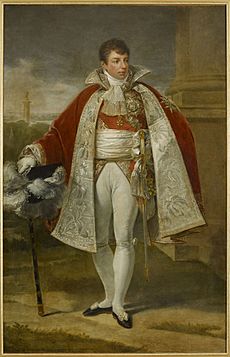 |
Gérard-Christophe-Michel Duroc, duc de Frioul (1772–1813) | 1805 | 218 × 142 cm | Palace of Versailles |
| Battle of Aboukir, 25 July 1799 | 1806 | 578 × 968 cm | Palace of Versailles | |
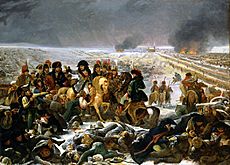 |
Battle of Eylau, 9 February 1807 | 1807 | 104.9 × 145.1 cm | The Louvre |
| Impératrice Joséphine | 1808 | Musée des Beaux-Arts de Nice | ||
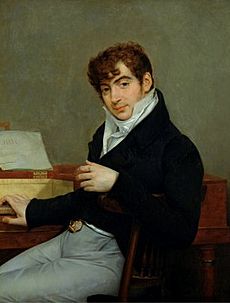 |
Portrait of the French composer Pierre Zimmermann | 1808 | 118.5 × 91 cm | Palace of Versailles |
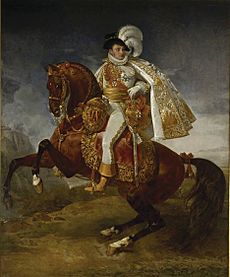 |
Equestrian portrait of Jérôme Bonaparte | c. 1808 | 321 × 265 cm | Palace of Versailles |
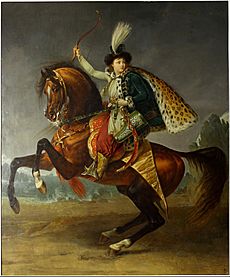 |
Equestrian portrait of Prince Boris Yusupov | 1809 | 321 × 266 cm | Pushkin Museum |
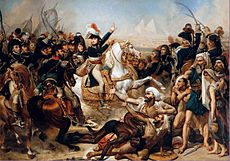 |
Battle of the Pyramids | 1810 | 389 × 311 cm | Palace of Versailles |
 |
Napoleon accepts the surrender of Madrid, 4 December 1808 | 1810 | 361 × 500 cm | Musée de l'Histoire de France (Versailles) |
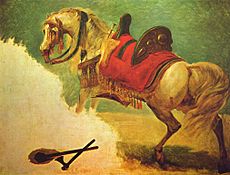 |
The Horse of Mustapha Pasha | c. 1810 | 89 × 175 cm | Musée des Beaux-Arts et d'archéologie de Besançon |
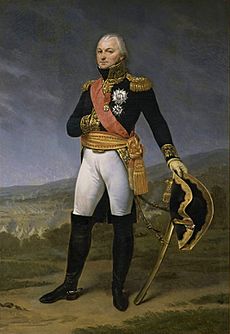 |
Portrait of General Claude Legrand | c. 1810 | 245 × 172 cm | Palace of Versailles |
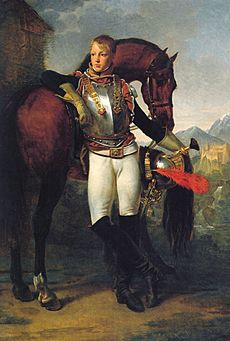 |
Portrait of Second Lieutenant Charles Legrand | c. 1810 | 249 × 162 cm | Los Angeles County Museum of Art |
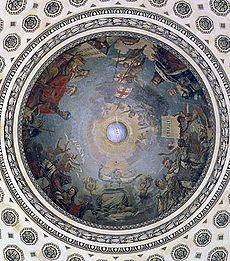 |
The Apotheosis of Saint Genevieve | 1811–1824 | Panthéon de Paris | |
| François I and Charles V Visiting the Church of Saint-Denis | 1812 | The Louvre | ||
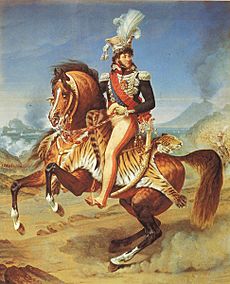 |
Equestrian portrait of Joachim Murat | 1812 | 89 × 175 cm | Musée des Beaux-Arts et d'archéologie de Besançon |
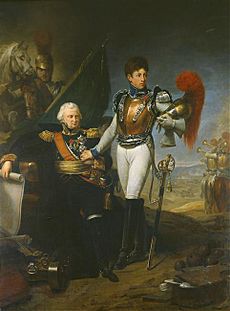 |
General Baston de Lariboisière and his son Ferdinand | c. 1815 | Musée de l'Armée | |
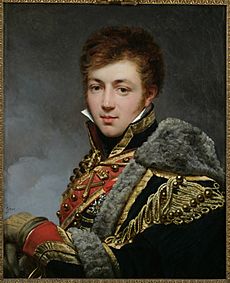 |
Honoré-Charles Baston de Lariboisière | 1815 | 73 × 59 cm | Private collection |
| Departure of Louis XVIII from the Palace of the Tuileries on the Night of 20 March 1815 | 1817 | 405 × 525 cm | Palace of Versailles | |
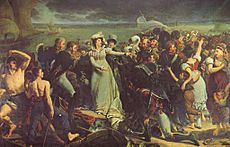 |
Embarkation of Madame d'Angoulême | 1819 | 326 × 504 cm | Musée des Beaux-Arts de Bordeaux |
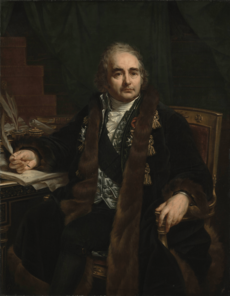 |
Count Jean-Antoine Chaptal | 1824 | Musée des Beaux-Arts de Bordeaux | |
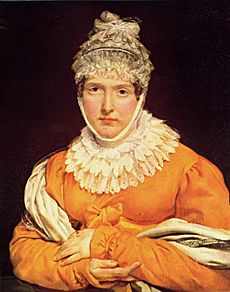 |
Portrait of Madame Récamier | 1825 | 62.3 × 51.2 cm | Croatian Academy of Sciences and Arts |
| The Genius of France Giving Life to the Arts and Protecting Humanity | c. 1827 | The Louvre | ||
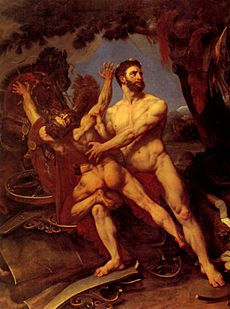 |
Hercules and Diomedes | 1835 | 426 × 324 cm | Musée des Augustins |
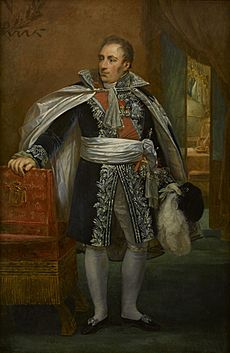 |
Portrait of Pierre Daru | 19th century | 216 × 142 cm | Palace of Versailles |
See also
 In Spanish: Antoine-Jean Gros para niños
In Spanish: Antoine-Jean Gros para niños
- Félix Louis Leullier
- Napoleon legacy and memory


